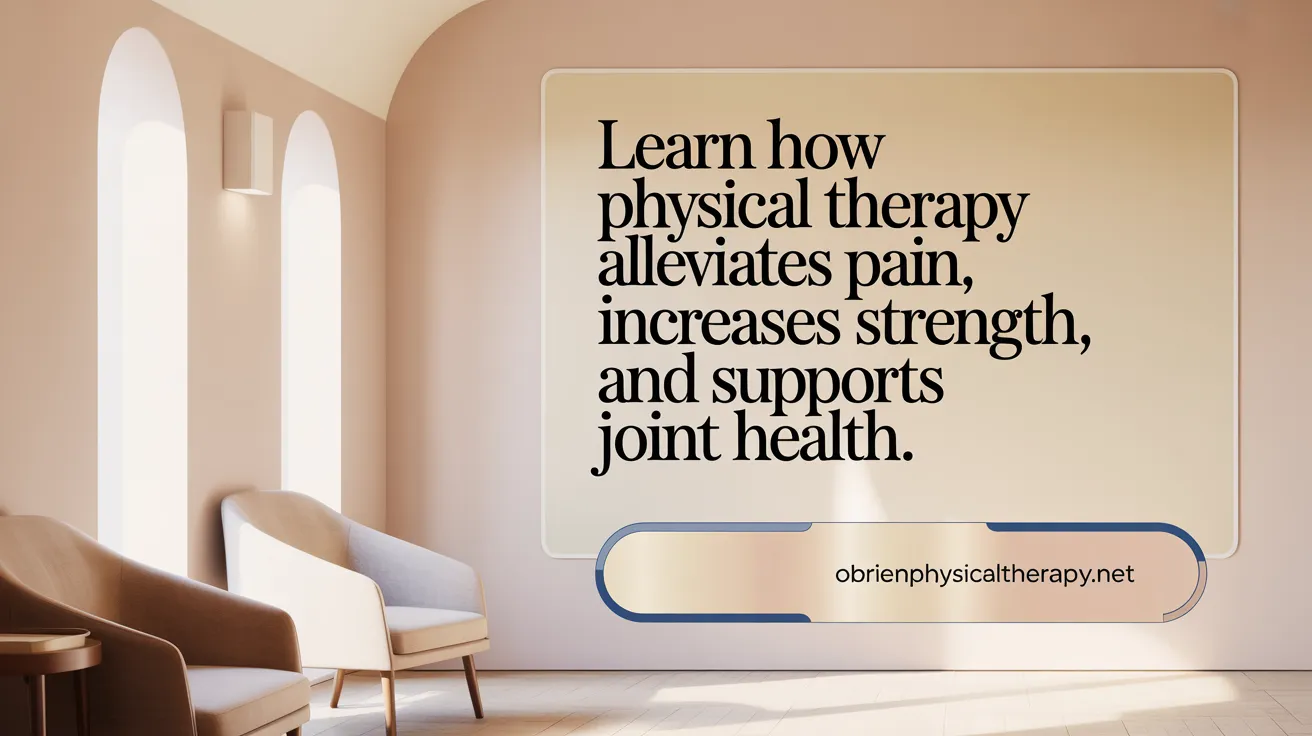Understanding the Power of Physical Therapy for Arthritis
Arthritis, a leading cause of joint pain and disability worldwide, affects millions by limiting mobility and diminishing quality of life. Physical therapy (PT) emerges as a vital, non-pharmacological intervention designed to alleviate arthritis symptoms, restore joint function, and empower patients to live more independently. This article explores how physical therapy helps manage arthritis symptoms, detailing the benefits, techniques, and goals of treatment while highlighting its safety and effectiveness as a cornerstone of arthritis management.
How Physical Therapy Eases Arthritis Symptoms

How does physical therapy help manage arthritis symptoms?
Physical therapy plays a vital role in managing arthritis by targeting the root causes of joint pain and dysfunction. It improves joint mobility and increases muscle strength around affected areas, which provides better support and stability to arthritic joints. Personalized exercise routines are central to treatment, focusing on range-of-motion exercises like stretching, resistance training, and aerobic activities such as walking or swimming.
Therapists also teach patients proper posture, body mechanics, and activity modifications to prevent further joint stress and damage. This education helps patients perform daily activities safely and efficiently, reducing discomfort.
Additional treatments like manual therapy, heat or cold applications, and assistive devices—such as braces, splints, or shoe inserts—further soothe inflammation and stiffness. Regular physical activity, under professional guidance, can slow disease progression, improve movement, and boost overall quality of life.
Exercise programs tailored for arthritis
Exercise is one of the most effective ways to maintain joint health. Therapists design routines that include stretching for flexibility, strengthening exercises to support joints, and low-impact aerobics for endurance.
Water-based activities, like swimming or hydrotherapy, reduce joint pressure due to buoyancy, easing pain and improving strength.
Consistency is crucial; research shows that programs lasting at least 12 weeks significantly reduce symptoms and improve function.
How does physical therapy reduce pain and inflammation?
Physical therapy employs techniques such as manual joint mobilization, massage, ultrasound, and electrical stimulation to decrease inflammation and pain. Hot or cold therapy helps manage swelling and soothe sore tissues.
Strengthening the muscles around the joints reduces the stress on weakened joint structures, providing better support and minimizing pain.
Educating patients on proper body mechanics
A major part of therapy involves teaching patients how to move correctly during daily activities. Proper posture and ergonomic adjustments prevent excess joint stress.
Therapists also guide patients on lifestyle modifications, such as weight loss, diet, stress management, and activity modification, contributing to symptom control.
Assistive devices and environmental modifications
Using cane, walker, or orthotic devices correctly can prevent joint overload and improve mobility. Ergonomic adjustments at home and work — such as supportive furniture or grab bars — help reduce joint strain and prevent stiffness.
Long-term management strategies
Ongoing physical activity and adherence to personalized exercise routines are essential for sustained symptom relief. Regular check-ins with a physical therapist ensure exercises remain effective and adapt to changes in the condition.
In some cases, physical therapy can delay or avoid the need for joint surgery, making it a valuable part of long-term arthritis management.
| Aspect of Management | Techniques and Interventions | Benefits |
|---|---|---|
| Exercise Programs | Range of motion, strength, endurance | Improve joint function, reduce stiffness |
| Pain and Inflammation | Manual therapy, heat/cold therapy, electrical stimulation | Reduce pain, decrease swelling |
| Education and Modifications | Proper body mechanics, lifestyle changes, ergonomics | Prevent joint damage, promote safe activity |
| Assistive Devices | Braces, shoe inserts, mobility aids | Enhance mobility, reduce joint stress |
| Overall Goal | Customized treatment plans with consistent practice | Diminish symptoms, delay progression |
Benefits and Goals of Physical Therapy for Arthritis Patients
 Physical therapy provides a comprehensive approach to managing arthritis, focusing on alleviating pain and enhancing joint function. Its benefits include reducing discomfort, increasing joint flexibility and range of motion, and strengthening surrounding muscles to support affected joints. This strengthening not only improves stability but also helps protect joints from further damage.
Physical therapy provides a comprehensive approach to managing arthritis, focusing on alleviating pain and enhancing joint function. Its benefits include reducing discomfort, increasing joint flexibility and range of motion, and strengthening surrounding muscles to support affected joints. This strengthening not only improves stability but also helps protect joints from further damage.
By engaging in tailored exercises, patients can improve their overall mobility and flexibility, making daily activities easier and less painful. Physical therapy also emphasizes teaching proper body mechanics and posture, which are vital for reducing stress on joints during routine tasks. This education empowers patients to maintain healthy movement patterns, actively participate in their care, and prevent injury.
Supportive techniques such as the use of assistive devices (e.g., braces, shoe inserts) and therapies like hot or cold treatments further assist in managing symptoms. Regular follow-up sessions allow therapists to adapt individualized programs that target specific needs, enhancing long-term outcomes.
The ultimate goal of physical therapy is to restore as much joint function as possible, improve strength and balance, and support independence. Patients can expect decreased stiffness, less pain, and better quality of life as they gain confidence in their physical capabilities.
Through sustained effort and professional guidance, physical therapy aims to help arthritis patients maintain mobility, prevent further deterioration, and achieve better long-term health and well-being.
Physical Therapy Techniques and Treatment Methods for Arthritis

What techniques and treatment methods are used in physical therapy for arthritis?
Physical therapy for arthritis involves a comprehensive set of techniques aimed at reducing pain, improving joint mobility, and restoring overall function. Therapists develop personalized exercise programs that target flexibility, strength, balance, and coordination, helping patients regain mobility and reduce stiffness.
Common treatment methods include various types of exercises such as stretching, range-of-motion, and resistance training. These exercises are often complemented by low-impact aerobic activities like swimming, cycling, and walking, which promote cardiovascular health while being gentle on affected joints.
Manual therapy, including joint mobilizations and soft tissue massage, helps enhance joint movement and reduce muscle tension. Modalities like heat therapy are used to relax muscles and increase blood flow, while cold therapy helps decrease inflammation and swelling.
Assistive devices such as canes, walkers, and braces are demonstrated and integrated into treatment plans to support joint stability and prevent pain or stiffness during daily activities.
Therapists also recommend modifications in the patient's environment—such as ergonomic adjustments—to minimize stress on joints and ease movement.
Another important aspect is hydrotherapy and aquatic exercise, where performing activities in heated pools provides buoyancy that reduces joint pressure, alleviating pain while strengthening muscles.
Education and training are integral to physical therapy, with therapists instructing patients on proper posture, body mechanics, and techniques for safe exercise at home. This education empowers patients to continue treatment independently, which is crucial for long-term management.
Overall, these combined approaches are tailored to each individual's needs, aiming to improve mobility, reduce pain, and enhance quality of life. Regular assessment and adjustments ensure the therapies remain safe and effective, often helping delay or avoid the need for surgical interventions.
Suitability, Safety, and Effectiveness of Physical Therapy for Arthritis

How effective and safe is physical therapy for arthritis patients?
Physical therapy is a well-established treatment option for arthritis, including osteoarthritis and rheumatoid arthritis. When tailored to each person's specific condition and needs, it offers numerous benefits.
The primary goals are to reduce joint pain, enhance mobility, and strengthen muscles around affected joints. Typical approaches include aerobic activities like walking or swimming, resistance exercises, and manual therapies such as massage and joint mobilization.
Research consistently supports its effectiveness. Multiple clinical studies and systematic reviews have shown that physical therapy can significantly alleviate pain, improve joint function, and boost overall quality of life.
The safety profile of physical therapy is high, with minimal risk of adverse effects when executed properly. Treating with a qualified physical therapist ensures exercises and interventions are appropriate and safe.
Use of assistive devices, education on joint protection, and proper use of modalities like hot/cold therapy further enhance safety and outcomes. Nevertheless, individual responses vary, and therapy plans should always be guided by healthcare professionals.
In summary, physical therapy is both effective and safe for managing arthritis symptoms, provided interventions are personalized and carefully implemented.
Educational Insights: Empowering Patients Through Physical Therapy

What educational information should patients know about physical therapy as a treatment option for arthritis?
Patients diagnosed with arthritis should understand that physical therapy is a highly effective, personalized approach to managing their condition. It involves tailored exercises designed to enhance joint flexibility, strength, and overall mobility, which can significantly reduce pain and stiffness.
Physical therapists play a vital role in teaching patients proper posture and body mechanics, guiding them on how to perform daily activities without stressing their joints. They also recommend assistive devices such as braces, splints, shoe inserts, and walking aids, which can help alleviate joint pressure and prevent further damage.
In addition to exercises, therapies like hot and cold packs, and lifestyle modifications including weight management, stress control, and activity adjustments, are integral parts of comprehensive arthritis care.
Patients are encouraged to engage regularly with their physical therapy routines and follow prescribed exercises at home, which over time can enhance their function and overall quality of life. Ongoing education about disease management techniques empowers individuals to take an active role in their treatment, leading to better outcomes and improved well-being.
The Vital Role of Physical Therapy in Arthritis Management
Physical therapy stands out as a comprehensive, effective, and safe approach for managing arthritis symptoms and improving patients' quality of life. Through individualized exercises, manual techniques, patient education, and supportive therapies, PT addresses pain, stiffness, and functional limitations integral to arthritis. Patients benefit from strengthened muscles, enhanced mobility, and greater confidence in daily activities, potentially delaying the need for surgical interventions. Importantly, adherence to tailored physical therapy plans fosters long-term joint health and independence. Collaborating with qualified therapists, individuals with arthritis can empower themselves with the knowledge and skills necessary to live actively and comfortably despite their condition.
References
- Physical Therapy for Arthritis
- How Does Physical Therapy Help Arthritis?
- Physical therapy as a promising treatment for osteoarthritis
- How Can Physical Therapy Help with Arthritis
- Movement is Medicine: Physical Therapy & Arthritis
- Can Physical Therapy Help Your Arthritis?
- Managing Arthritis Pain With Physical Therapy
- Can Physical Therapy Help Arthritis? Spokane ...
- Can physical therapy reduce arthritis pain?
- Why Does Physical Therapy for Arthritis Help?
